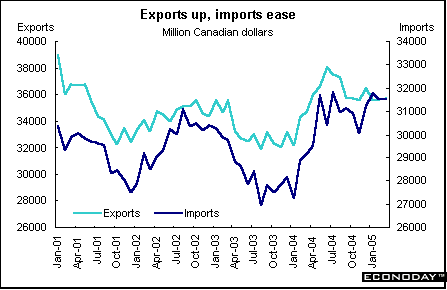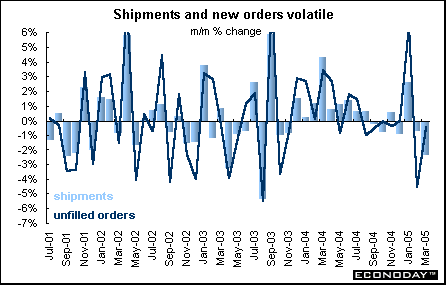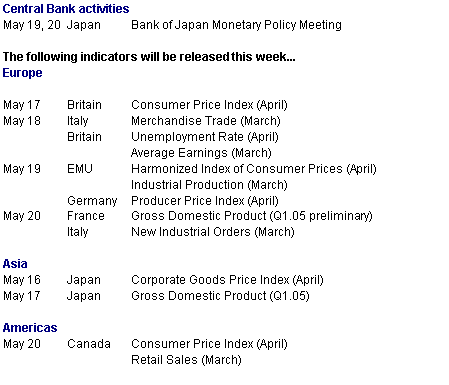Monday, May 16, 2005

Bank of England keeps 4.75 percent interest rate
The Bank of England's Monetary Policy Committee left interest rates at 4.75 percent for the ninth month in a row in response to mounting evidence that the economy has entered a soft patch. The Bank was confronted by new economic data that highlighted a growing dilemma for the Monetary Policy Committee - to find the appropriate interest rate policy in the face of rising inflationary pressures on the one hand and slowing economic activity on the other. Industrial output contracted sharply in March while at the same time prices were rising rapidly for manufactured products as well as input prices. Economic activity appears to be weakening with no prospect of the industrial sector providing an offset to faltering consumer spending. Consumer spending started to slow sharply after the Bank raised interest rates to their current level in August 2004. That marked the end of a series of rate increases that were designed to cool down the then booming property market. Bank of England Governor Mervyn King on March 24th described the slowdown in consumer spending as "marked" and the greatest risk to the bank's forecasts for growth and inflation. The Bank had postponed their May meeting by 48 hours because of the May 5th general election. Instead of Wednesday, policy makers began their monthly deliberations on Friday morning.
Britain's interest rates are the highest among the Group of Seven industrialized nations. The U.S. Federal Reserve has raised its key rate eight times since June 2004 to 3 percent, while the European Central Bank has left rates unchanged at a six-decade low of 2 percent for 24 months. British growth is still forecast to outpace that of the EMU this year and next. The European Commission predicts that the UK will grow 2.8 percent this year and next, compared with 1.6 percent and 2.1 percent for the euro area.
The MPC meeting was followed a couple of days later by the Bank's quarterly "Inflation Report" in which it reduced its economic growth forecast for this year, bolstering expectations of an interest rate reduction in the second half of the year. The Bank revised its 2005 growth forecast downward to 2.6 percent from the previous projection of 2.7 percent. Inflation is expected to exceed the bank's 2 percent target before settling near its 2 percent target at the start of 2007 according to Bank of England Governor Mervyn King. He also said the MPC had concurred in February (in the previous inflation report) that the main downside risk was to the near term consumption. But since February, the risk appears to have crystallized. Household spending weakness has become more marked and has persisted into the year. The Bank also said that the housing market seemed to have stabilized. But the combined effect of the slowdown in house price inflation and the effect of higher interest rates on highly indebted households may be associated with a more prolonged slowdown in consumer spending.
The Bank also said that inflation had risen more sharply than expected. The inflation forecast is "somewhat higher in the first year than in February but lower further out, reflecting the appreciation of sterling and the more subdued prospect for (economic) activity". The near term acceleration in inflation will be driven by higher prices for water and waste services, with higher prices of imported goods also putting upward pressure on price growth according to the Bank. Inflation will then decelerate and settle around the bank's 2 percent target "as the impact of higher oil prices and other transient influence on the inflation rate abate."
Global Markets
Equities continued to be pressured in competing directions by earnings reports - some good, some bad - and falling commodity prices that adversely affected resource companies especially in Asia and Europe. Falling crude prices, thanks to higher inventory data, did not quite offset worries about economic growth and the negative impact of lower fuel costs on the profits of energy and mining companies. However, technology stocks appeared to recover some of their recent heavy losses thanks to a stellar performance by Dell in the first quarter. Only three of the 13 indexes followed here were up on the week.
Global Stock Market Recap

Europe and Britain
Unfortunately, the positive performance of the May's first week didn't last into the second. The FTSE, CAC and DAX declined the first three days of the week, but were up on Thursday. The CAC and DAX barely moved into positive territory on Friday while the FTSE cut its losses thanks to a positive Dow just before the European market close. Thursday's brief hiatus in positive territory was helped by falling crude prices - the indexes do still rise and fall on oil price movements - and stronger-than-expected U.S. data. The U.S. trade deficit shrank while retail sales were higher than expected. The DAX was pressured downward on Friday by steelmaker ThyssenKrupp AG, when its earnings missed analysts' estimates. Raw material and energy companies' stocks were down as metal prices slid and oil traded near lows not seen since February. And a disappointing U.S. consumer sentiment report only added to the gloom. European commodities stocks including Total SA and BHP Billiton declined as oil reached a three-month low and raw material prices had their biggest two-day drop in seven weeks.
Part of the FTSE's problem was the reduction in company stock prices as they began trading without dividends. Also weighing on British equities was the Bank of England's forecast that inflation would breach its 2 percent target this year - earlier than it had expected - before falling back, leading some to conclude that the bank will be unlikely to reduce its interest rate any time soon.

In its monthly report, the European Central Bank voiced growing concern about persisting economic divergences among EMU members and urged structural reform in underperforming countries. The ECB acknowledged that variations in economic growth and inflation rates had persisted in spite of the introduction (in 1999) of the euro and a single interest rate policy. However, the ECB denied that the divergences had worsened since then and said its job had not been made more difficult by the weaknesses. It said that much of the divergence resulted from structural difficulties that governments should tackle. Monetary policy had to be set according to the overall eurozone outlook. The bank noted continuing differences in growth with Italy and Germany having on average the lowest real gross domestic product growth since 1999.
Asia/Pacific
After a week of holidays and market closures to celebrate them, investors returned to Asian markets without enthusiasm. In Japan, better-than-expected machine orders only lessened Friday's decline while much better-than-expected U.S. retail sales did not bolster exporter stocks either. Rather, slumping commodity prices took their toll on companies such as BHP Billiton, the world's biggest mining company, and Rio Tinto Group, the third largest. In Australia, energy stocks have gained the most so far this year, rising 14 percent as a group. The energy index has dropped 7 percent since its March 21st peak. Both the all ordinaries and STI were up on the week.

Japanese indexes have been afflicted by a disappointing earnings season so far. Notwithstanding the usual revisions, almost half of the non-financial companies that have reported have missed consensus expectations. Since revisions and leaked numbers started trickling out around a month ago, the Nikkei 225 has slumped about 5 percent. And foreigners, the stalwart buyers of recent years, turned net sellers for much of April. So far, around half of the companies' forecasts are below market expectations.
Currencies
Despite the market's focus on a possible Chinese currency revaluation, the dollar gained ground against the euro, reaching a new high since October 2004. The reduced March U.S. trade deficit shifted, at least for the time being, investors' focus from structural concerns to growth differentials. Meanwhile, notwithstanding a sharp jump in German first quarter gross domestic product, official estimates of second quarter EMU growth have been revised downward. There are additional reasons for dollar strength. If the French vote against the European constitution on May 29th, the euro could come under further pressure. Some also argue that if the Chinese currency is revalued, investors would buy Asian currencies hoping for further appreciation and would sell the euro, which has borne the brunt of dollar weakness.

The yen also weakened against the dollar as Sadakazu Tanigaki, the Japanese finance minister, said a revaluation of the Chinese renminbi would not necessarily lead to yen strength. The yen strengthened from ¥108.80 against the dollar to ¥104.03 in the four weeks to May 5th, largely because of speculation that China was moving towards a revaluation, and that this in turn would encourage other Asian nations to allow their currencies to shadow the Chinese unit higher.
Debate about a pending change in yuan policy remained the focus for foreign exchange players and kept most major currency pairs locked in tight trading ranges as the week began. The yen and other Asian currencies declined as Asian markets returned to full liquidity following the Labor Day/Golden Week holiday. But the currency markets were convulsed Wednesday when the China's People's Daily newspaper said it incorrectly translated a report placed on its English language online edition to say that a change in the yuan's peg will be announced next week. China's currency has been allowed to trade within 0.3 percent of about 8.3 per dollar since 1995. Permitting the yuan to trade more freely would address criticism from Fed Chairman Alan Greenspan and U.S. Treasury Secretary John Snow that the peg gives Chinese exports an unfair advantage. The spokesman for China's central bank said there is no timetable for a change in the yuan and furthermore, the bank has never given advance notice of major policy changes.
Indicator scoreboard
EMU - First quarter flash gross domestic product was up 0.5 percent and 1.4 percent when compared with the first quarter a year ago. As with all flash estimates, no component changes were available.

Germany - March seasonally adjusted industrial output dropped 0.8 percent but was up 1.6 percent when compared with last year. Industrial output excluding construction, the ECB preferred measure, was down 0.2 percent and up 3 percent on the year. The decline in total industrial output was due primarily to a drop in construction (down 10.8 percent) and energy goods output (down 5.2 percent). However, manufacturing output was up 0.3 percent after sinking 2.1 percent in the previous month.

March seasonally adjusted merchandise trade surplus was €15.1 billion, up from €13.2 billion in February. On an unadjusted basis, the surplus climbed to €16.3 billion from €13.6 billion in February. Exports to countries within the European Union were up 1.3 percent on the year while imports were up 0.3 percent. Exports to other EMU countries jumped 3.7 percent on the year while imports from these countries jumped 6.5 percent. Exports to countries outside the EU dropped 3.6 percent on the year while imports plunged 12.9 percent.

First quarter flash gross domestic product jumped 1 percent and was up 1 percent when compared with the first quarter in 2004. The increase was due solely to net exports. Overall domestic demand dropped on the quarter. As with all flash data, no data for GDP components were available.

France - March seasonally adjusted industrial output excluding construction dropped 0.5 percent both on the month and on the year. Manufacturing output sank by 0.9 percent and was down 0.4 percent on the year. Autos were down by 1.4 percent while capital goods dropped 1 percent and consumer goods were down 0.5 percent. Energy output was up 1.3 percent.

March seasonally adjusted merchandise trade deficit was €2.4 billion, larger than February's deficit of €1.7 billion. Exports were down 2.1 percent while imports were up 0.2 percent. Exports were down for all sectors with the exception of energy. Imports were up because of energy as well as imports of clothing (from China).

Italy - March seasonally and workday industrial production was down 0.6 percent and sank 2.9 percent when compared with March 2004. Consumer goods output declined 2.5 percent while investment goods were up 0.6 percent. Leather and footwear industry output sank 7.1 percent while clothing and textiles were down 3.6 percent.

First quarter preliminary gross domestic product was down 0.5 percent and dropped 0.2 percent when compared with last year. This plunged the economy into a technical recession - GDP has declined for two quarters. As with the flash releases for the EMU and Germany, no details for the components were available.

Britain - March industrial output sank 1.2 percent and plunged 1.9 percent when compared with last year. Manufacturing output declined 1.6 percent and was down 1.1 percent on the year. Twelve of 13 major manufacturing output categories were down.

April producer output prices were up 0.7 percent and 3.2 percent when compared with last year. Core output prices, which exclude food, tobacco, petroleum and beverages, were up a more modest 0.3 percent and 2.7 percent on the year. Producer input prices were up 0.3 percent and 10.4 percent on the year.

March global merchandise trade deficit narrowed to Stg4.412 billion from Stg5.037 billion in February. The non-EU trade deficit declined to Stg2.047 billion in March from Stg2.687 billion in the previous month. The EU deficit was virtually unchanged at Stg2.365 billion. Global exports were up 3.4 percent while imports were down 0.4 percent on the month. Excluding oil and other erratic items, the global goods trade deficit narrowed to Stg4.912 billion from Stg5.141 billion in February. The combined goods and services deficit narrowed to Stg3.075 billion from Stg3.487 billion. The services surplus declined to Stg1.337 billion from Stg1.550 billion.

April retail sales in stores open at least a month sank 4.7 percent when compared with last year. This is the biggest decline on since comparable figures began in 1995. March sales had been up 1.8 percent on the year. The British Retail Consortium survey covered the four weeks between April 3rd and April 30th. Total retail sales, which include new store openings, dropped 1.3 percent after gaining 5.4 percent March. The earlier Easter holiday this year may have exacerbated the decline. Clothing demand and footwear sales sank but so did sales of appliances, audio and video equipment. Retail sales account for around 40 percent of consumer spending.
Asia
Australia - April employment was up by 7,000 jobs and the unemployment rate remained at 5.1 percent for the fifth month. Full time employment was up by 39,100 while part time positions fell 32,200. Australia's 5.1 percent jobless rate compares with 5.2 percent in the U.S., 11.8 percent in Germany (March) and 4.5 percent in Japan (March). The labor force participation rate was unchanged at 64.5 percent.

Americas
Canada - March merchandise trade balance was C$4.2 billion, virtually unchanged from February. Exports inched up by 0.2 percent while imports were flat. Energy exports were up by 10.6 percent, primarily as the result of an 11.6 percent increase in national gas exports. Canada's trade surplus with the United States edged up marginally to C$8.09 billion, and the trade deficit with all other countries remained at $3.9 billion.

March factory shipments sank 2.4 percent but were up 2.7 percent when compared with last year. Sixteen of 21 manufacturing industries, accounting for 80 percent of total shipments, reported declines. Excluding the transportation equipment sector, total manufacturing shipments were down 0.2 percent, but this drop was offset by high industrial prices for petroleum and coal products. Crude oil prices, which soared to new heights, sent price-inflated shipments of petroleum up 7.3 percent. Motor vehicle manufacturers' shipments sank 11.4 percent while the part industry plummeted 10.2 percent. Despite the slump in shipments, the backlog of unfilled orders rose by 2.1 percent, a two-year high. Unfilled orders were up 7.2 percent on the year. New orders declined 0.5 percent after sinking 4.6 percent in the previous month. They were up 4.3 percent on the year.

Bottom line
Better growth won the day in the currency markets last week. Other than Germany's surprise 1 percent gain in the first quarter, EMU growth looks moribund with Italy declining for the second quarter - it is now in what is called a technical recession - and French growth which will be announced this week and promises to be weak as well. While German growth looks good on the surface, all of it stemmed from net exports, with domestic demand non-existent. And as the French and Dutch referendums on the EU constitution become imminent, the uncertainties grow for market players.
Looking Ahead: May 16 through May 20, 2005




